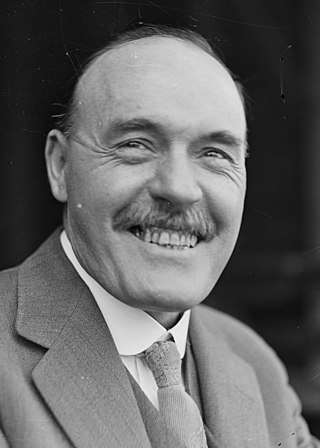
David Watkins was an Australian politician. He was an Australian Labor Party member of the New South Wales Legislative Assembly for Wallsend from 1894 until 1901. At Federation, he was elected to the new Australian House of Representatives as the Labor member for Newcastle and served until his death in 1935. Watkins' death left former Prime Minister Billy Hughes as the only remaining member of the First Parliament still in the House.
Walter Peden Joyce Skelton MBE was an Australian politician, elected as a member of the New South Wales Legislative Assembly.

John Lionel Fegan was a politician and coal miner in New South Wales, Australia.

Reginald Walter Darcy Weaver was an Australian conservative parliamentarian who served in the New South Wales Legislative Assembly for 28 years. Serving from 1917 in the backbenches, he entered the cabinet of Thomas Bavin in 1929 as Secretary for Mines and Minister for Forests until he returned to opposition in 1930. Following the success of the United Australia Party in the 1932 election, Weaver returned as the Secretary for Public Works and Minister for Health in the Stevens ministry.

Sir George Stephenson Beeby KBE was an Australian politician, judge and author. He was one of the founders of the Labor Party in New South Wales, and represented the party in state parliament from 1907 to 1912. He fell out with the party and later served as an independent, a Nationalist, and a Progressive. He left parliament in 1920 to join the state arbitration court, and in 1926 was appointed to the Commonwealth Court of Conciliation and Arbitration. He was Chief Judge from 1939 until his retirement in 1941.

Arthur Hill Griffith was a politician, teacher and patent attorney in New South Wales, Australia. He was a member of the New South Wales Legislative Assembly from 1894 until 1917 and held a number of ministerial positions in the Government of New South Wales. He was a member of the Labor Party.
Julie Sutton is a former New South Wales politician and Marriage Celebrant, elected as a Councillor of Warringah Council and was previously Mayor of Warringah from 1995 to 1996 and 2002 to 2003.
Members of the New South Wales Legislative Assembly who served in the 25th parliament of New South Wales held their seats from 1920 to 1922. They were elected at the 1920 state election on 20 March 1920. The Speaker was Daniel Levy with the exception of 13–20 December 1921 when he was replaced by Simon Hickey.
Members of the New South Wales Legislative Assembly who served in the 15th parliament of New South Wales held their seats from 1891 to 1894 They were elected at the 1891 colonial election between 17 June and 3 July 1891. The Speaker was Sir Joseph Palmer Abbott.

The 1925 New South Wales state election was held on 30 May 1925. This election was for all of the 90 seats in the 27th New South Wales Legislative Assembly and was conducted in multiple-member constituencies using the Hare Clark single transferable vote. The 26th parliament of New South Wales was dissolved on 18 April 1925 by the Governor, Sir Dudley de Chair, on the advice of the Premier Sir George Fuller.
Annandale, an electoral district of the Legislative Assembly in the Australian state of New South Wales, had two incarnations, the first from 1894 to 1920, the second from 1927 to 1950.
Balmain, an electoral district of the Legislative Assembly in the Australian state of New South Wales, has had three incarnations since it was established in 1880. It expanded from 1 to 2 to 3 to 4 members before being abolished in 1894. It was re-established in 1904 returning 1 member until 1920. When multiple member constituencies were established using the Hare-Clark single transferable vote in 1920, Balmain returned 5 members. It had a single member from 1927 when the state returned to single member electorates. It was abolished in 1991 and largely replaced by Port Jackson which included the Sydney CBD. It was re-established in 2007 when Port Jackson was abolished.
Wollongong, an electoral district of the Legislative Assembly in the Australian state of New South Wales, has had three incarnations, the first from 1904 to 1920, the second from 1927 to 1930, and the third from 1968 to the present.
Newcastle, an electoral district of the Legislative Assembly in the Australian state of New South Wales, has had two incarnations, from 1859 until 1894 and from 1904 to the present.
Albert Charles Willis was an Australian politician.

John Daniel FitzGerald was a politician, union official, journalist and barrister in New South Wales, Australia.
Patrick Joseph Minahan, was an Irish-born Australian politician.
Kahibah, an electoral district of the Legislative Assembly in the Australian state of New South Wales, has had three incarnations, the first from 1894 to 1920, the second from 1927 to 1930 and the third from 1950 to 1971.
Sturt, an electoral district of the Legislative Assembly in the Australian state of New South Wales, had two incarnations, from 1889 until 1968 and from 1971 until 1981.
Leichhardt, an electoral district of the Legislative Assembly in the Australian state of New South Wales, had two incarnations, from 1894 to 1920 and from 1927 to 1962.






